How can we create a device that will stop the transmission of noise pollution within a certain area?
Grade 9
Presentation
No video provided
Problem
Irritation caused by constant unwanted noises such as the buzz of a crowded workplace or the loud music from your neighbour's porch can be incredibly distracting. These sounds are referred to as noise pollution and can make it difficult to focus or relax, leading to increased stress levels over an extended period. From a societal view, studies have shown that noise pollution can increase stress-related illnesses, hearing problems, high blood pressure, etc. As a solution, we have decided to create a sound-cancelling device to actively address the issue by eliminating unwanted noise.
Our device will follow the concept of Active Noise Cancellation, utilizing a microphone to detect external noise, an amplifier to process the noise, and a speaker to generate the opposite sound wave (anti-wave), effectively cancelling the incoming noise.
Method
Concepts
Sound
Sound is a form of energy made by vibrations that can be transmitted through different surfaces and materials. As something vibrates, the surrounding molecules vibrate, moving back and forth, bumping into other nearby molecules, causing them to vibrate. This movement continues until the molecules reach a surface that either absorbs or blocks the vibrations. This is called sound waves. The lower the speed of vibrations, the quieter the sound, and vice versa.
Materials that transmit sound:
- Solids:
- Sound travels fastest through solids because the particles are closely packed together, which allows the vibrations to be transmitted more efficiently.
- Examples: Metal, wood, glass, and stone.
- Liquids:
- Sound travels slower in liquids in comparison to solids but faster than in gases.
- Examples: Water, oil, alcohol.
- Gases:
- Sound travels slower in gases because the particles are more spread out, making it harder for the vibrations to pass from one particle to another.
- Examples: Air (the most common medium for sound), and helium.
- Vacuum
- Sound cannot be heard in a vacuum (outer space) as no surrounding particles transmit the vibrations.
Sound waves
Sound waves are the result of vibrations created by something. An example of this is a guitar string. When you pluck the string, it vibrates, creating sound waves that travel through a medium.
There are two main types of sound waves:
Longitudinal: Sound waves fall mainly under this category. This is where all the particles in a medium vibrate in the same direction as the wave.
Transverse: This is where the displacement of the particles is perpendicular to the direction of the wave.
Properties of sound waves include:
- Frequency: The number of vibrations a wave makes per second. It is measured in Hz and determines the pitch of a sound, higher frequencies mean higher pitch and lower frequencies mean lower pitch.
- Amplitude: Amplitude is the height of a wave, the taller the wave the louder the sound.
- Wavelength The distance a sound wave travels during one complete cycle, from crest to crest or trough to trough.
- Velocity: The rate at which a sound wave travels through a medium. Depends on the properties of that medium.
Understanding the difference between constructive interference and destructive interference
Comprehending the difference between constructive and destructive interference was a crucial part when creating the device. Using the example of two sound waves helps explain this concept. Constructive interference happens when two sound waves align and combine, producing a wave with greater amplitude, and making the sound louder. In contrast, destructive interference occurs when two waves are out of sync and cancel each other out, reducing or eliminating the sound. Our device uses this principle, and with the help of microphone detection, detects the incoming noise and generates a sound wave with the opposite phase, effectively cancelling out unwanted noise through destructive interference.
Understanding Noise pollution
We use different terms to describe sounds. Music typically refers to organized sounds that are pleasant or harmonious, while noise refers to unpleasant and harsh sounds. In contrast, noise pollution refers to unwanted sounds that can harm humans and other organisms, affecting their health and overall well-being. Studies have shown that noise pollution can lead to stress-related illnesses, hearing problems, high blood pressure, and speech interference. Examples include car honking in busy cities, aircraft noise, and sirens.
Active Noise Cancellation
Active noise cancellation (ANC) is the process of detecting incoming sound waves and creating an opposing wave to cancel them out. This differs from passive noise cancellation, which relies on physical barriers to block sound rather than actively counteracting it. ANC works by using microphones to detect ambient noise and a small processor to generate an inverse sound wave with the same amplitude but in an opposite phase. When these two waves combine, they cancel each other out through destructive interference, effectively reducing unwanted noise. In contrast, passive noise cancellation works by physically blocking sound using materials such as thick padding, tight-fitting ear cups, or in-ear seals. These barriers reduce the amount of external noise that reaches the ears.
Microphones
Microphones work by converting sound waves in the air into electrical signals
- When sound waves are produced, the microphone's diaphragm captures them causing the diaphragm to vibrate
- These movements/vibrations correspond to the volume and pressure of the sound waves it captures (loud noises create large movements while soft noises create small movements.)
- With dynamic microphones, the diaphragm is attached to a coil of wire that is placed within a magnetic field. As the diaphragm moves, the coil also moves generating a small electric current that mirrors the sound wave.
- After the movement is converted to an electric signal, it can be amplified, recorded, etc
- Lastly, to output the sound, the signal is processed after being sent to a recording device or speaker.
Types of microphones:
| Microphone Type | How It Works | Frequency Response | Directionality | Latency & Signal Clarity | Power Required? | Sensitivity | Cost Range |
|---|---|---|---|---|---|---|---|
| Dynamic Microphone | Uses electromagnetic induction—sound waves move a diaphragm attached to a coil within a magnetic field, generating an electrical signal. | 50Hz – 15kHz (limited range, struggles with high frequencies) | Cardioid (picks up mainly from the front, rejects sides and back) | Slower response, lacks detail in high frequencies | No (generates its own signal, no external power needed) | Low (-56 to -52 dBV/Pa, ~1.5mV/Pa) | 💲 $50–$1,000+ |
| Condenser Microphone | Uses a capacitor with a charged diaphragm—sound waves change the distance between plates, producing a highly sensitive electrical signal. | 20Hz – 20kHz (captures full human hearing range, excellent high-frequency detail) | Omnidirectional / Cardioid (versatile pickup patterns, depending on model) | Quick response, captures subtle sound variations accurately | Yes (Phantom Power 48V or battery required) | High (-40 to -28 dBV/Pa, ~10–25mV/Pa) | 💲 $100–$3,000+ |
| Ribbon Microphone | Uses a thin aluminum ribbon suspended in a magnetic field—sound waves vibrate the ribbon, inducing an electrical signal. | 20Hz – 15kHz (smooth, natural sound but weak high frequencies) | Figure-8 (picks up front and back, rejects sides) | Slower response, requires a strong preamp for a usable signal | No (passive, but may need a preamp) | Very low (-60 to -55 dBV/Pa, ~0.5–1mV/Pa) | 💲 $200–$4,000+ |
| Lavalier Microphone | A miniature condenser microphone, often wireless—captures sound through a tiny diaphragm and transmits it via radio frequency (RF) or wired connection. | 50Hz – 18kHz (good for speech but lacks depth) | Omnidirectional / Cardioid (depends on model, but often omni for speech clarity) | Fast response, but small diaphragm limits richness | Yes (Battery or Wireless RF power required) | Moderate (-50 to -40 dBV/Pa, ~3–10mV/Pa) | 💲 $30–$1,000+ |
| Shotgun Microphone | Uses an interference tube to reject off-axis sounds—captures audio from a narrow front angle while minimizing background noise. | 40Hz – 18kHz (good for dialogue, focused on mids and highs) | Highly directional (supercardioid/lobar pattern, captures sound only from the front) | Fast response, but limited area of pickup | Yes (Phantom Power or Battery required) | Moderate (-45 to -35 dBV/Pa, ~5–20mV/Pa) | 💲 $150–$2,500+ |
For our project, we intend to use a cheap, durable, and efficient microphone to support our device. From the research presented in this table, we can conclude that a condenser microphone is best suited for this task.
Its high sensitivity (-40 to -28 dBV/Pa) is a key reason. It can detect even the slightest variations in sound pressure, allowing for the precise capture of incoming sound waves, ensuring that our system accurately represents the original sound. High sensitivity is crucial for our application, as it ensures that even low-volume sounds are effectively picked up and processed for noise cancellation.
Additionally, a wide frequency response (20Hz – 20kHz) allows it to capture both low and high frequencies, making it suitable for a range of environmental sounds. Its fast signal response ensures minimal lag, effective for real-time sound processing in our device.
Furthermore, condenser microphones are also available at affordable prices ($100+), making them a cost-effective solution while maintaining the necessary performance for our project.
Speakers
Types of speakers:
1. Dynamic Speakers
Dynamic speakers are the most common and widely used type, typically found in home audio systems, headphones, and portable speakers. They operate using three main components: a diaphragm, a voice coil, and a magnet. The diaphragm is a thin, flexible material that vibrates to produce sound. The voice coil is attached to the diaphragm and moves within the magnetic field created by the permanent magnet. When an audio signal passes through the voice coil, it interacts with the magnetic field, causing the diaphragm to move, creating sound waves. Dynamic speakers are favored due to their robustness, affordability, and ability to cover a broad range of frequencies.
- Strengths: High durability, good all-around sound quality, cost-effective
- Applications: Home audio, studio monitors, portable speakers, headphones
2. Electrostatic Speakers
Electrostatic speakers utilize a completely different principle, relying on a thin, electrically charged diaphragm placed between two stators (electrodes). When an audio signal is fed into the stators, it creates an electric field that interacts with the diaphragm. The diaphragm, which is very light and thin, moves in response to the electric field, producing sound with minimal distortion. These speakers are particularly prized for their clarity and low distortion, making them popular in high-end audio setups.
- Strengths: High clarity, minimal distortion, extremely accurate sound reproduction
- Applications: High-end audiophile systems, home theaters, professional sound setups
3. Planar Magnetic Speakers
Planar magnetic speakers combine aspects of dynamic and electrostatic designs, offering the best of both worlds. The diaphragm in these speakers is typically flat, and it is suspended between two sets of magnets. The diaphragm is made from a thin, conductive material with a pattern of traces that carry the audio signal. When the signal passes through the traces, it creates a magnetic interaction with the magnets, causing the diaphragm to move. This movement produces sound. Planar magnetic speakers are highly regarded for their exceptional sound quality, wide soundstage, and low distortion.
- Strengths: High fidelity, low distortion, wide soundstage, excellent for precise sound reproduction
- Applications: Audiophile-grade speakers, high-end home theaters, reference monitors
4. Horn Speakers
Horn speakers use a horn-shaped structure to amplify sound. The horn acts as a waveguide, directing sound in a more focused and efficient manner, which helps amplify the sound without requiring a significant increase in power. The basic principle behind horn speakers is that they use the shape and acoustics of the horn to increase sound pressure and direct it more efficiently into the environment. This design is widely used in professional sound reinforcement systems due to its efficiency and ability to project sound over long distances.
- Strengths: High efficiency, powerful output, great for projecting sound in large spaces
- Applications: Public address systems, concert venues, professional audio setups
5. Subwoofers
Subwoofers are specialized speakers designed to handle low-frequency sounds (bass), typically below 100 Hz. These speakers are built with large drivers, often featuring reinforced materials to handle the power required to move large amounts of air. Subwoofers are essential in audio setups that aim to reproduce the deep, resonating bass frequencies often found in music, film soundtracks, and video games. They work by using large enclosures to maximize the movement of the diaphragm and amplify the low-frequency sounds effectively.
- Strengths: Deep bass reproduction, adds richness to sound, and enhances low-end frequencies
- Applications: Home theaters, car audio systems, music production
6. Tweeters
Tweeters are designed to reproduce high-frequency sounds, typically in the range of 2,000 Hz to 20,000 Hz, also known as treble frequencies. These speakers are much smaller than other types and are optimized to handle the very fast vibrations needed to produce crisp and clear high-frequency sound. Tweeters often use materials like silk, titanium, or aluminum for their diaphragms, which contribute to their ability to accurately reproduce high-pitched sounds without distortion.
- Strengths: Crisp and clear high frequencies, high resolution
- Applications: Home audio systems, hi-fi speakers, car audio
7. Midrange Speakers
Midrange speakers are designed to handle the frequencies between the bass and treble ranges, typically from about 500 Hz to 5,000 Hz. These frequencies are critical for reproducing most of the musical content in audio, including vocals and a wide range of instruments. A good midrange speaker ensures that voices and instruments sound natural and lifelike. The midrange driver often operates in conjunction with tweeters and subwoofers in a multi-driver system to achieve a full range of sound.
- Strengths: Natural and balanced sound, good for vocals and most instruments
- Applications: Full-range speaker systems, home audio, studio monitors
8. Full-range Speakers
Full-range speakers are designed to reproduce a wide range of frequencies using a single driver, usually covering from around 50 Hz to 20 kHz. These speakers aim to produce bass, midrange, and treble frequencies all at once, without the need for multiple drivers. While they may not achieve the same level of detail in each frequency range as specialized drivers, full-range speakers are often used for compact systems or portable audio devices where space and cost constraints are a consideration.
- Strengths: Compact, cost-effective, wide frequency coverage from a single driver
- Applications: Portable speakers, budget home audio systems, compact audio setups
9. Bone Speakers
Bone speakers use bone conduction technology to transmit sound vibrations directly through the bones of the skull, bypassing the eardrum entirely. This is achieved by placing a transducer against the skull, often near the temples or jawbone. The vibrations from the transducer travel through the bones to the cochlea (inner ear), where they are interpreted as sound. Unlike traditional speakers, bone speakers leave the ear canal open, allowing users to remain aware of their surroundings while still hearing audio. This feature makes them particularly useful in situations where hearing external sounds is important, such as while exercising outdoors.
Strengths:
- Allows for environmental awareness since the ear canal remains open
- Useful for individuals with hearing impairments or eardrum damage
Applications:
- Sports and fitness (e.g., cycling, running, or working out)
- Assistive listening devices for people with hearing impairments
- Situations where environmental awareness is crucial (e.g., driving or outdoor activities)
What makes a good speaker:
Sound Quality:
-
Clarity:
A speaker that produces clear, distortion-free sound across all volume levels is ideal. This means it should be able to reproduce audio with excellent detail, ensuring the elements are sharp and well-defined. At higher volumes, clarity is crucial to prevent indistinct sounds. -
Accuracy:
Accuracy refers to how well the speaker reproduces sound as it was intended by the original recording. A high-accuracy speaker will closely mimic the sound as captured in the studio or performance. This requires precise engineering of the speaker components, including the diaphragm, voice coil, and housing, to avoid altering the audio. -
Balance:
Good balance means the speaker handles the low, mid, and high frequencies evenly. No frequency range should dominate the others. For example, bass-heavy speakers that overpower mids and highs can make music sound muffled, while treble-heavy speakers may produce piercing, uncomfortable sounds. A balanced speaker ensures that each part of the audio spectrum is represented naturally, making it ideal for various genres and soundscapes.
Frequency Responses:
- Wide Range:
The frequency range indicates how well a speaker can reproduce the full spectrum of human hearing, typically from 20 Hz to 20 kHz. A wider range enables the speaker to capture deeper bass notes (around 20 Hz) and high frequencies (around 20 kHz). A speaker that can handle both extremes provides a more dynamic and immersive listening experience, which is especially important for high-fidelity audio reproduction.
Sensitivity:
- Sensitivity is measured in decibels (dB) and refers to how efficiently a speaker converts electrical power into sound. A higher sensitivity means that the speaker requires less power to achieve a given volume. For example, a speaker with higher sensitivity can produce louder sound with less power, making it ideal for smaller amplifiers or portable speakers. Sensitivity is important in achieving the optimal listening experience without overdriving the amplifier or wasting energy.
Power Handling:
-
RMS and Peak Power:
The RMS (Root Mean Square) power rating indicates the continuous power a speaker can handle without distortion over long periods. A higher RMS rating generally means the speaker can handle sustained volume levels without damage. Peak power, on the other hand, refers to the maximum amount of power a speaker can handle in short bursts. Adequate power handling ensures the speaker can perform well at various volume levels without risking damage to the components. -
Dynamic Range:
Dynamic range refers to the speaker’s ability to reproduce both quiet and loud passages in a piece of music or audio. A good speaker should handle low-volume sounds (like a whisper) with clarity, while also maintaining the integrity of loud sounds. A speaker with good dynamic range avoids distortion in both extremes.
Distortion:
- Low Distortion:
Distortion occurs when the speaker alters the original sound in a way that is not intended by the source material. A high-quality speaker will have low distortion, meaning it can maintain the audio’s integrity even at higher volumes. Distortion typically occurs when the speaker is pushed beyond its capabilities, leading to a breakdown in clarity and accuracy. A good speaker keeps distortion levels minimal, especially at high volumes, ensuring the sound stays clear.
Impedance:
- Compatibility:
Impedance is the resistance a speaker offers to the electrical signal from an amplifier. Speakers typically have impedance ratings of 4 ohms, 6 ohms, or 8 ohms. It’s crucial to match the speaker’s impedance with that of the amplifier to ensure efficient power transfer and optimal performance. If the impedance is too low, the amplifier may overheat or get damaged; if too high, the speaker may not receive enough power to perform at its best. Matching impedance ensures the best synergy between the speaker and amplifier, maximizing both longevity and performance.
For our device, we are using a bone-conduction speaker due to its many advantages. Unlike regular speakers, which rely on air to transmit sound, bone-conduction speakers generate vibrations through solid surfaces, allowing for more direct and precise wave generation. This improves the efficiency of producing the opposing sound waves needed for noise cancellation. Additionally, bone-conduction speakers are highly portable and easily mountable due to their compact and lightweight design. They can be attached to various surfaces without requiring large enclosures, making them ideal for integration into different environments. Another major advantage is their sound quality. Because they transmit vibrations directly, they reduce distortion and external interference, leading to clearer and more effective noise cancellation.
How the device works in detail
| Materials | Cost | ||
| Bone-Conduction Speaker | $40 | ||
| Enclosure Box | $20 | ||
| Amplifier circuit | $40 | ||
| Condenser Microphone | $20 | ||
| Wire 5m | $10 | ||
| Power supply | $25 |
How the bone-conduction speaker emits the inverse sound wave.
General view:

Top View:
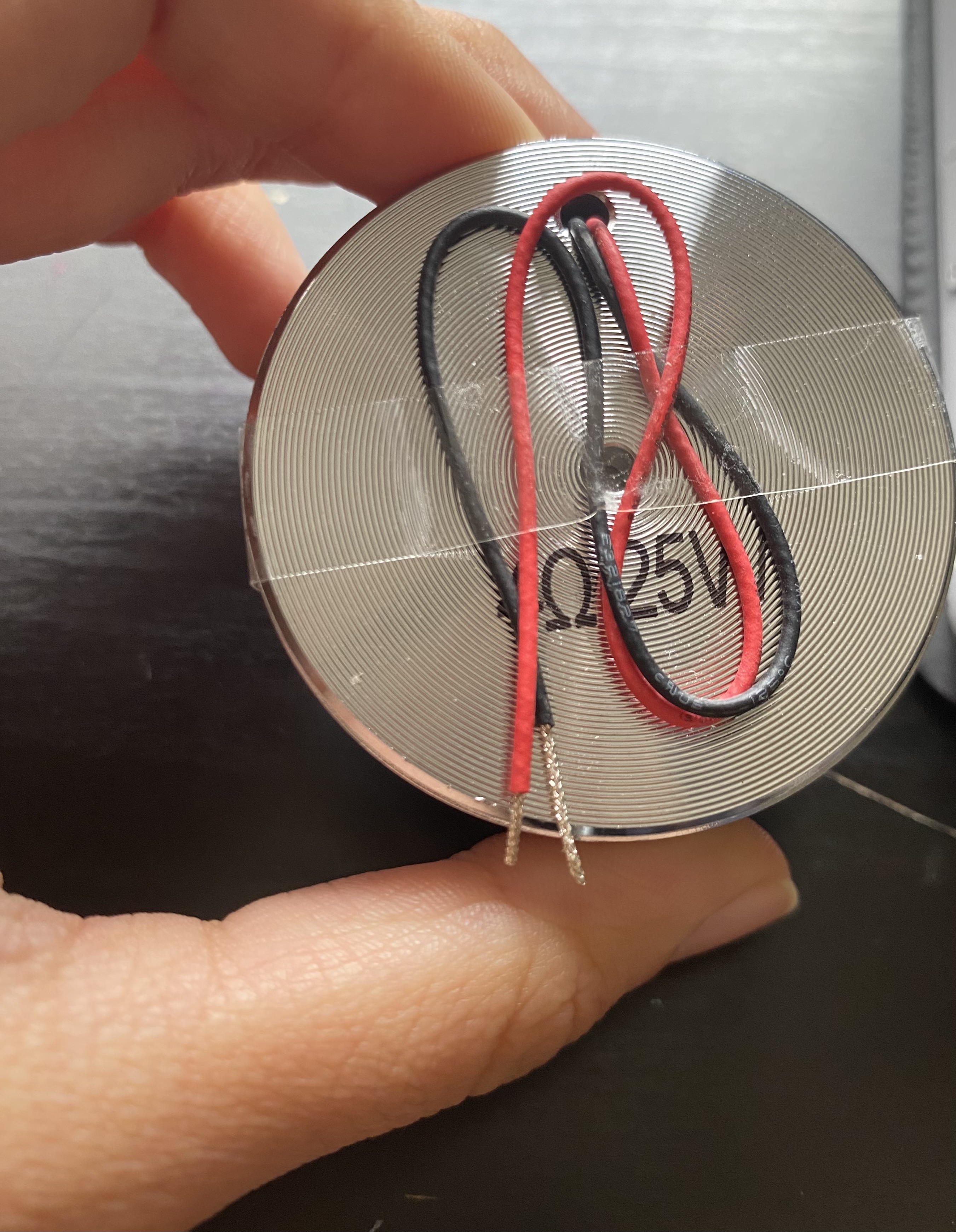
Bottom View:
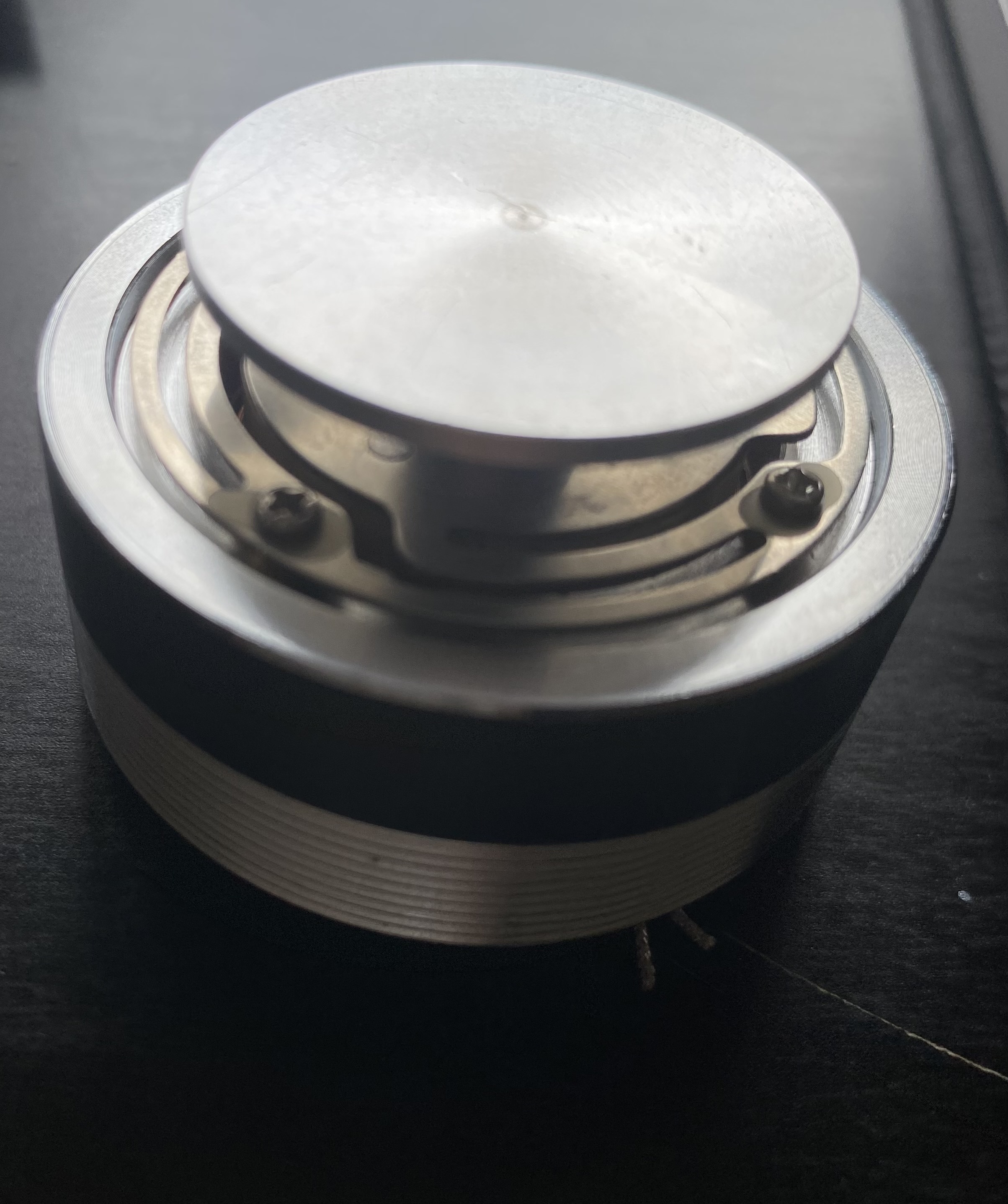
Depending on the wiring configuration, the bone-conduction speaker emits a sound wave that either matches or opposes the incoming wave detected by the microphone. When connected normally, the speaker transmits the same sound as the microphone detects. However, crossing the wires reverses the polarity, causing the speaker to produce an inverted wave, which is the opposite of the original signal.
Additionally, the back of the bone speaker allows it to be easily mounted making it very accessible. It can clip onto any surface providing significant efficiency.
Diagrams:
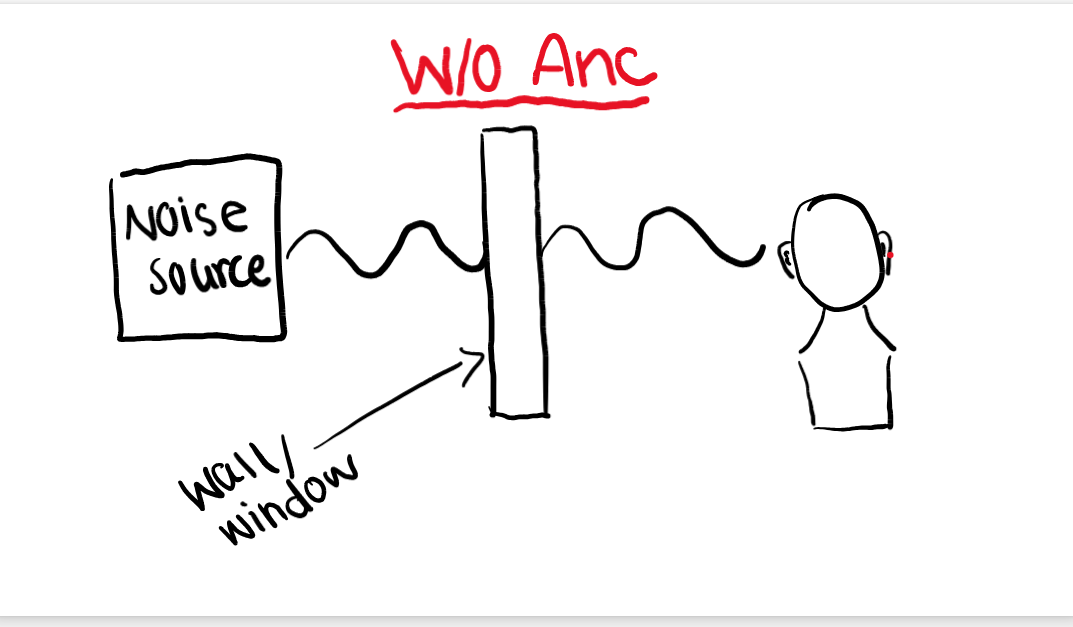
The diagram above demonstrates how sound waves travel to your ear without Active Noise Cancellation (ANC).
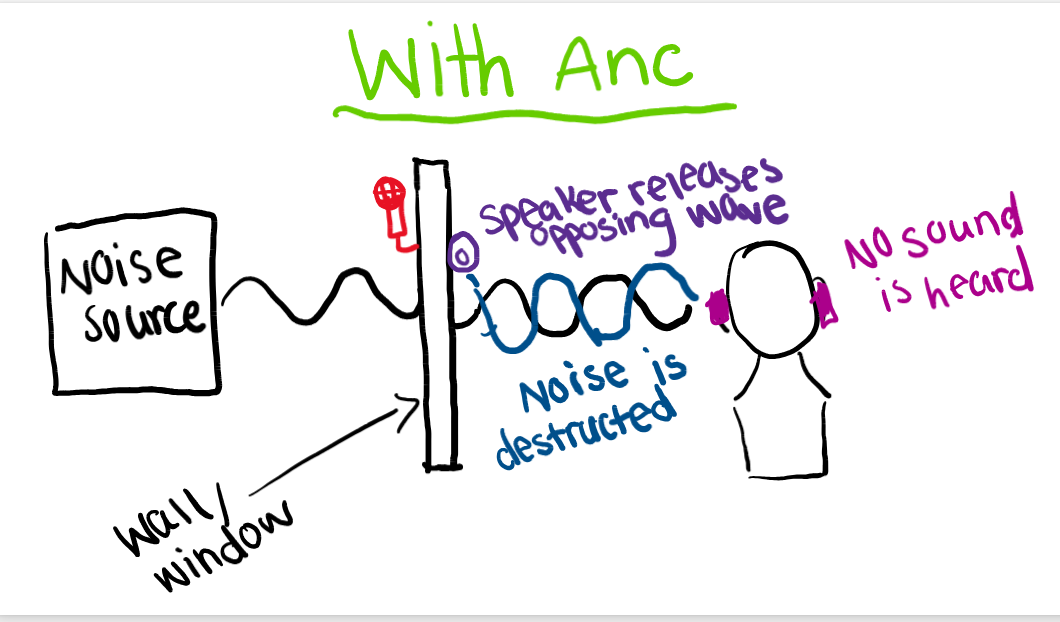
The diagram above illustrates how Active Noise Cancellation (ANC) neutralizes incoming noise. As the sound wave from the noise source travels through the wall/window, our condenser microphone attached to the surface detects the sound. This signal is then sent to the bone speaker, which generates and emits an inverse sound wave to cancel out the unwanted noise.
How the technology will be set up:
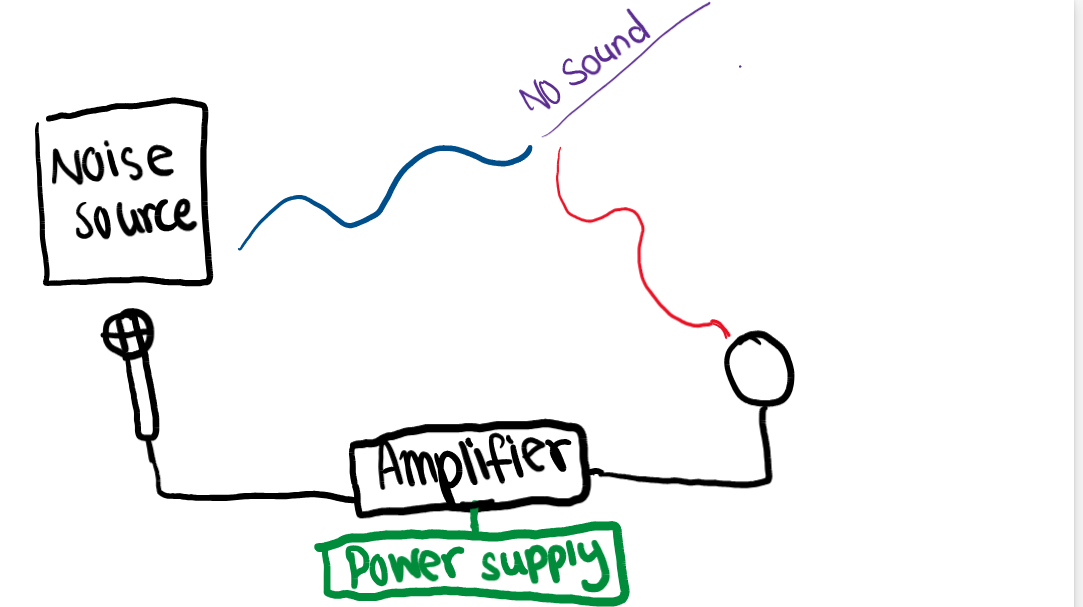
This diagram demonstrates a more detailed view of how our project will be set up, highlighting the contribution of each part.
Description
Noise pollution is a growing issue, especially in urban environments where constant exposure to traffic, sirens, and other loud sounds can be disruptive and even harmful. As a solution, there are two main approaches to noise reduction: passive and active noise cancellation. Passive noise cancellation relies on reflective and absorptive properties of materials to block high-frequency sound waves. This is often achieved through dense materials or specially designed barriers that physically prevent sound from passing through. While this method is useful, it has limitations when dealing with low-frequency sounds, which tend to pass through barriers more easily. On the other hand, Active Noise Cancellation is specifically designed to counter low-frequency noises. ANC is specifically selected for our device as we aim to address these low-frequency sound sources, such as an emergency vehicle siren, which supports a more noise-free environment.
Analysis
So far, we have gathered all the necessary materials for our project, including a condenser microphone, a bone-conduction speaker, and other essential components for testing active noise cancellation. However, we encountered an issue with the amplifier circuit board, as we received the wrong one. Because of this, we have been unable to collect data as planned and must wait for the correct amplifier to arrive before proceeding with testing. Despite this, our hypothesis remains the same. We believe our device will effectively reduce noise by using active noise cancellation (ANC). We predict that the microphone will accurately detect external noise, the amplifier circuit will process the signal, and the bone-conduction speaker will emit an inverse sound wave that effectively cancels out the unwanted sound. If the system works as expected, it should help solve noise pollution. To address the problem of not having data to analyze, we will create our device immediately after the correct amplifier circuit board arrives and gather data through testing to present on our trifold.
Conclusion
Overall, our research focused on understanding the principles behind active noise cancellation (ANC) and how it can be used to reduce unwanted sound through destructive interference. We explored key concepts such as sound wave properties, the role of microphones in detecting external noise, the function of amplifiers in processing signals, and how bone-conduction speakers can emit inverse sound waves to cancel out noise. Additionally, we examined the applications of ANC technology and its effectiveness in different frequency ranges, particularly in reducing mid-range and higher-frequency sounds.
Throughout the research process, we encountered several challenges that hindered our progress. For starters, we accidentally purchased the wrong amplifier circuit board, which heavily delayed data collection. Due to this setback, we were unable to obtain experimental data for analysis. However, we plan to collect and analyze the results by the time of the science fair. Despite not being able to conduct hands-on testing, we still managed to review existing research on ANC technology, giving us an idea of its potential and limitations. Our findings suggest that factors such as microphone accuracy, speaker placement, and processing algorithms can effect the performance of ANC technology.
Additionally, with our device, the potential applications in daily life are large, ranging from uses in urban environments, such as reducing the sound of traffic and other common sources of noise pollution, to high-end professional levels where high concentration is required in areas such as workplaces.
In contrast to noise-cancelling headphones or earplugs, our device proves to be much more reliable in blocking sound whilst still being aware of your surroundings. This is a vital point, as traditional noise-cancelling headphones typically cover your ear canal, blocking out external sounds completely. This could be dangerous as it isolates the user from important sounds or movements that could be potentially harmful.
Despite these benefits there are a few downsides to address. For one, bringing a noise-cancelling device with you all the time would be quite impractical as it could be bulky and prone to breaking. In the future, if this idea were to advance, it would be wise to make our device into a small, portable version containing the same components. This would allow users to carry it around conveniently. Another potential issue is the device's range of noise cancellation; it may be difficult for it to properly cancel out noise in areas with fluctuating volumes compared to areas with controlled noise levels. To address this issue, we would have to learn more about adaptive noise cancelling, but that's a problem for another time.
Through this project, we gained a deeper understanding of how ANC technology functions and how it could be used in real-life situations to address the effects of noise pollution. Future research could focus on optimizing ANC for different environments, improving real-time signal processing, and exploring new materials for noise reduction. Although the device isn't complete yet, our research has provided valuable insights into how ANC works and its potential applications in everyday life.
Citations
Study.com. (n.d.). What are sound waves? Definition, types & uses. Study.com. https://study.com/academy/lesson/video/what-are-sound-waves-definition-types-uses.html
NASA. (n.d.). The science of sound. NASA. https://www3.nasa.gov/specials/Quesst/science-of-sound.html
Lenovo. (n.d.). Microphone. Lenovo. Retrieved March 9, 2025, from https://www.lenovo.com/ca/en/glossary/microphone/?orgRef=https%253A%252F%252Fwww.google.com%252F&srsltid=AfmBOopd--hnxJjvQYY0NvCZBYtVS1y4hJ87mpwcDg_n2kSZGpdYMv0O
TechTarget. (n.d.). Microphone. TechTarget. Retrieved March 10, 2025, from https://www.techtarget.com/whatis/definition/microphone
Khan Academy. (n.d.). Constructive and destructive interference [Video]. Khan Academy. https://www.khanacademy.org/science/physics/mechanical-waves-and-sound/standing-waves/v/constructive-and-destructive-interference
In Sheep's Clothing. (n.d.). Planar magnetic ribbon loudspeakers. In Sheep's Clothing. Retrieved March 17, 2025, from https://insheepsclothinghifi.com/planar-magnetic-ribbon-loudspeakers
Iberdrola. (n.d.). What is noise pollution? Causes, effects, and solutions. Iberdrola. Retrieved March 17, 2025, from https://www.iberdrola.com/sustainability/what-is-noise-pollution-causes-effects-solution
Bose. (n.d.). What is active noise cancellation? Understanding Bose technology. Bose. https://www.bose.com/stories/what-is-active-noise-cancellation
Popescu, I. (n.d.). Types of microphones: Choosing the right mic for every use. AVIXA. Retrieved March 19, 2025, from https://www.avixa.org/pro-av-trends/articles/types-of-microphones
Schiavi, L. (2020, June 9). Loudspeaker types and how they work. The Absolute Sound. Retrieved March 19, 2025, from https://www.theabsolutesound.com/articles/loudspeaker-types-and-how-they-work/
Matsakis, L. (2024, July 15). How noise-cancelling headphones work. SoundGuys. https://www.soundguys.com/how-noise-cancelling-headphones-work-12380/
-Chat GPT for limited research and Q&A purposes
Acknowledgement
We would like to thank the many people who have helped us along our journey, supporting us no matter the circumstances. First of all, we would like to thank Mrs. Friesen, our science fair coordinator who gave us endless support even through our struggles believing us no matter what. Without her, we wouldn't have been given such an opportunity and for that, we express heavy gratitude. We would also like to thank our parents for motivating us to continue even through our hardships and supplying us with the materials we needed. Thank you very much from the bottom of our hearts, we wouldn't have been able to make it without you!

